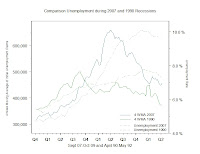


The economy is growing at a moderate rate according to testimony given by Fed Chairman Ben Bernanke (Greg Robb, "Fed's Bernanke sees moderate recovery ahead," Market Watch, April 14, 2010).
In testimony before the Joint Economic Committee of Congress, Bernanke said private demand would be sufficient to replace the diminishing government stimulus and inventory adjustment that have spurred growth in the past six months.
"On balance, the incoming data suggest that growth in private final demand will be sufficient to promote a moderate economic recovery in coming quarters," the top U.S. central banker said.
Continuing high unemployment is the fly in the recovery honey. Today's "Unemployment Insurance Weekly Claims Report" added another data point suggesting that improvements in the job market will be at a snails pace.
In the week ending April 10, the advance figure for seasonally adjusted initial claims was 484,000, an increase of 24,000 from the previous week's unrevised figure of 460,000. The 4-week moving average was 457,750, an increase of 7,500 from the previous week's unrevised average of 450,250.The three graphs at the top of the post compare the movement of the unemployment rate and four-week moving average of initial unemployment claims of the current recession with each of the previous three recessions. The graphs begin six weeks before each recession began and show that the three previous recessions had lower unemployment rates and initial claims than the current recession after 125 weeks.



This comment has been removed by a blog administrator.
ReplyDeleteAny time you have inflation within the economy there's going to be a high rate of unemployment, and the numbers are not going to always reflect the actual rate of unemployed citizens, because of those that don't show up within the workforce numbers due college, and stay at home parents so in actuality the unemployment rate is much higher than what is reported.
ReplyDelete